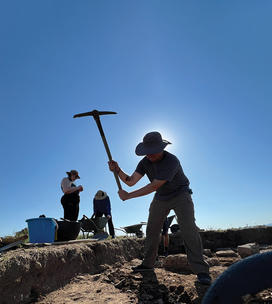Archaeology Project in Greece Unearths Major Findings
Students who take Nathan Arrington ’02’s class Archaeology in the Field get hands-on experience working at an excavation site in Greece
For six weeks in the summer of 2023, art and archaeology professor Nathan Arrington ’02, along with his class and collaborators in the Molyvoti, Thrace, Archaeological Project (MTAP), would set off for the city of Komotini, Greece, at 5:30 a.m. The early start ensured they could dig from 6 a.m. to 1 p.m. to avoid the scorching afternoon sun. Throughout this time, the group would rotate days of jumping into pits wielding pickaxes and shovels with days of learning about the excavated ceramics, seeds, plants, and bones — which students in Arrington’s class, Archaeology in the Field, wrote essays about.
MTAP, a collaboration between Princeton, the Ephorate of Antiquities of Rhodope, and the American School of Classical Studies at Athens, explores the history of an Archaic-Classical trading port and polis, often identified as Stryme — an ancient Greek city located on Molyvoti. The project has turned up a variety of findings that led researchers to unexpected paths. One of special intrigue is the extra urban sanctuary researchers unearthed near the village of Pagouria below a plowed cotton field. It is a temple that dates to the middle of the third century and housed at least one female deity.
The presence of worked antlers at the temple point to Artemis Bendis, the Thracian goddess of hunting. Yet a figurine found at the temple belongs to Athena, the goddess of wisdom, war, and crafts, and patron of the city of Athens, Arrington confirms. It is also quite possible that the deity is Kybele (or Cybele), the Phrygian mother of all gods, who was widely worshiped in Greece and the Roman Empire, he adds.

Other findings included the excavation of two buildings and establishment of the dimensions of the city and its grid plan. In total, MTAP has unearthed a whopping 26,704 specimens of animal bone from 60 different species, 2,804 plant specimens, and other artifacts that offer valuable insights into quotidian ancient Greek life and confirm the hypothesis that a bustling commerce center was once thriving on Molyvoti.
Arrington and his collaborators will soon begin publishing the findings of this research and all that’s been collected since the first excavation in 2013. The first volume, titled The Molyvoti, Thrace, Archaeological Project 1: Landscape, Architecture, and Material Culture, is scheduled to be released early next year. They plan to release three additional volumes in the future. The team is also in the process of creating an online database that the public can access to view the findings.
For students who participated in the excavation, it was a rewarding experience, says Ethan Spain ’26, a mechanical and aerospace engineering major. The class is open to students in all departments, as long as they are ready to roll up their sleeves and dig. The class allowed Spain to take his first international trip, and he found ways to connect the experience to his career interests. “It turns out the similarities with engineering were strong,” he says. “Your hypothesis is changing all the time, but you’re also working on one thing for a week at a time, and then you’re switching. And you’re relying on a lot of other experts to talk to you to reach conclusions.”
Although the fieldwork concluded in 2023, the project is not over. “Archaeology is where the hard sciences meet the humanities,” says Arrington, who believes there are many misconceptions around his scientific field. “The digging is always just the beginning. You have to make sense of the objects, which also have to be tended to and cared for.” So now they are finalizing conservation efforts and are in the study phase.
He adds, “There’s always more digging to do, but at some point, the responsible thing is to say, we’re stopping here.”












No responses yet